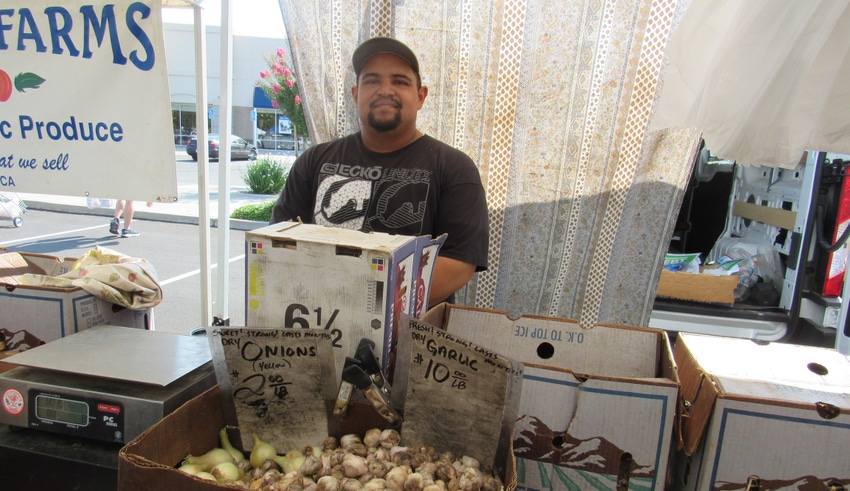
The extreme heat wave that has ushered in the summer of '21 is causing headaches for growers throughout the West Coast, as temperatures have soared as high as 115 degrees in Red Bluff, Calif., and flirted with a record 115 in normally misty Portland, Ore.
A string of afternoons with highs well into the 110s have dried out numerous crops in California's Central Valley, while elevated humidity has hurt hay quality in the Imperial Valley, according to the National Agricultural Statistics Service.
The heat is forcing some growers to use more water at a time when it's scarce because of drought. Newer corn plantings needed additional irrigation, as did stone fruit, NASS reported. But the quality of fruit has been affected by high temperatures and lack of rain, the agency observed.
Juan Toledo, owner of Toledo Farms in Galt, Calif., draws from wells to irrigate his 30 acres of fruit, heirloom tomatoes, peppers and zucchini.
"During the summer for us, we've got to water more frequently," he told Farm Press. The farm's water situation and crops are "OK for now," he said.
Uncommon heat in PNW
In California, the start of summer has been nearly identical to last year, as relatively cool temperatures in early June has given way to sweltering heat just as harvests are ongoing for numerous crops, including cherries, nectarines, plums, peaches, navel and Valencia oranges, apricots, lemons, blueberries, cucumbers, zucchini, squash and tomatoes.
In recent summers, prolonged heat in the Golden State has caused blue prune, in which plums for prunes drop prematurely; caused sunburn in tree nuts; damaged avocados; deteriorated the quality of forage; and caused a re-greening of Valencia oranges, forcing growers to treat them and divert them to domestic markets because some foreign trading partners don’t accept chemically treated fruit.
The difference this year is in the Pacific Northwest, where typically rainy Portland and Seattle were more than 30 degrees above their normal highs for Sunday, June 27, according to the National Weather Service. Portland set records with highs of 108 on June 26 and 112 on June 27. It was 113 there as of mid-afternoon June 28, and the high was expected to get to 115 degrees.
The region's hot weather had berry farmers scrambling to pick crops before they rotted on the vine, The Associated Press reported. Northwest cherry growers are in the middle of harvest and are moving 500,000 boxes a day, Washington State Fruit Commission president B.J. Thurlby told the AP. So far, the cherries appear to have good color and sugar, but hte heat wave is a new experience, he said.
“We have not been in these waters before,” Thurlby told the wire service. If the cherries get too hot, they will sunburn and dry out, he added.
The heat wave may not end soon. The federal Climate Prediction Center foresees a high likelihood of above-average temperatures throughout the western U.S. in the next two weeks, particularly in the Northwest and Northern Plains. The models favor above-average temperatures lingering through the summer.
Protect livestock
Washington State University Extension experts caution that livestock and pets are at risk from extreme heat.
“Our animals depend on us,” said Don Llewellyn, WSU associate professor and livestock extension specialist. “Livestock owners, farmers, and youth raising animals for 4-H and similar projects should prepare for heat and dangerous conditions.”
While different livestock and pet species have specific needs, Extension scientists give suggestions to keep animals safe.
Avoid stressful handling of livestock. If necessary, only do so in the early morning hours or late in the evening.
Ensure animals in barns or sheds have proper ventilation and air circulation.
Provide shade to animals kept outside, if possible.
Provide a continuous supply of cool, clean water. Water is very important, allowing animals’ bodies to cool off and stay cool. Sufficient water is particularly important for animals that are lactating or pregnant, to ensure health of nursing young as well as newborn animals.
Watch for signs of dehydration, such as lethargy, drying of the mucous membranes and eyes, or eyes that appear sunken and dull.
Clean water is also important. Excessive heat and stagnant water can promote blue-green algae growth, which has shown to be toxic to livestock, wildlife, and humans.
In times of heat stress, it may be necessary to reduce energy intake, such as from grains and concentrates, and increase fiber in the diets of animals such as 4-H steers and lambs, the specialists say.
Protect farmworkers
To prevent heat illness in humans working in fields, California's Division of Occupational Safety and Health recently reminded employers that state regulations require them to take the following measures:
Plan – Develop and implement an effective written heat illness prevention plan that includes emergency response procedures.
Training – Train all employees and supervisors on heat illness prevention.
Water – Provide drinking water that is fresh, pure, suitably cool and free of charge so that each worker can drink at least 1 quart per hour, and encourage workers to do so.
Shade – Provide shade when workers request it and when temperatures exceed 80 degrees. Encourage workers to take a cool-down rest in the shade for at least five minutes. They should not wait until they feel sick to cool down.
Cal/OSHA’s heat illness prevention standard applies to all outdoor worksites. In industries with with high-heat requirements such as agriculture, employers must observe workers regularly for signs of heat illness and establish effective communication methods so workers can contact a supervisor when needed.
[This story has been updated.]
About the Author(s)
You May Also Like






